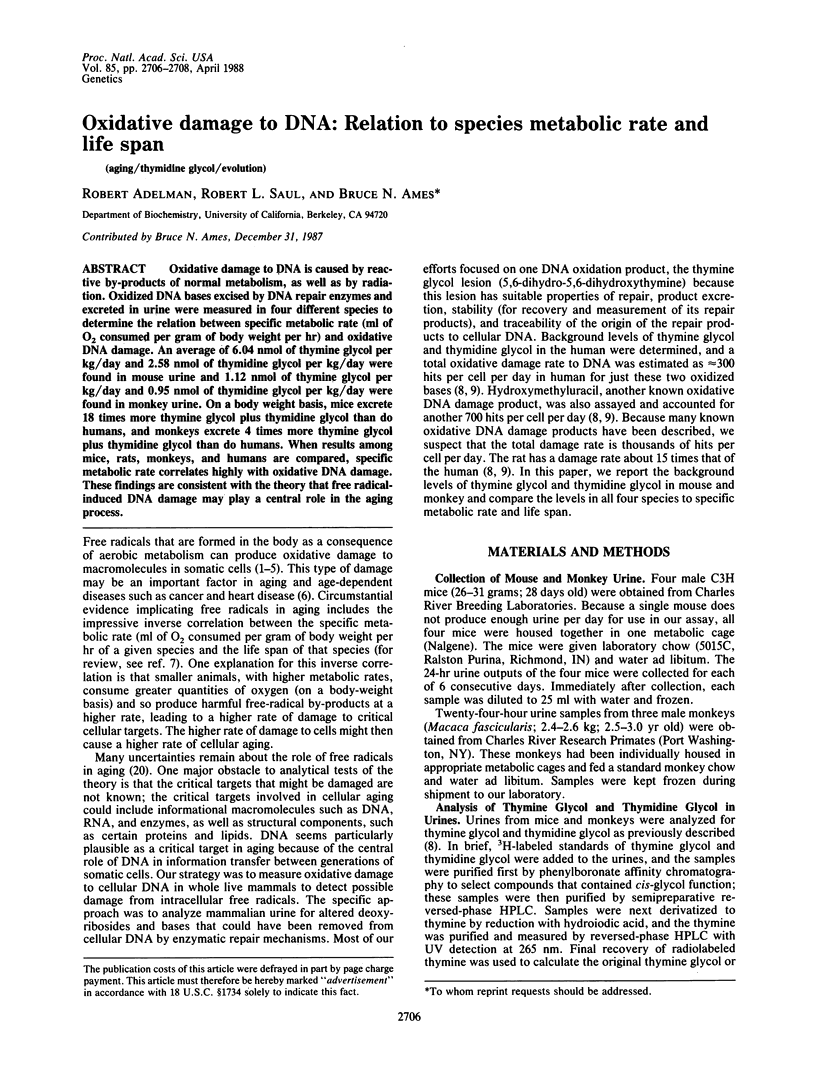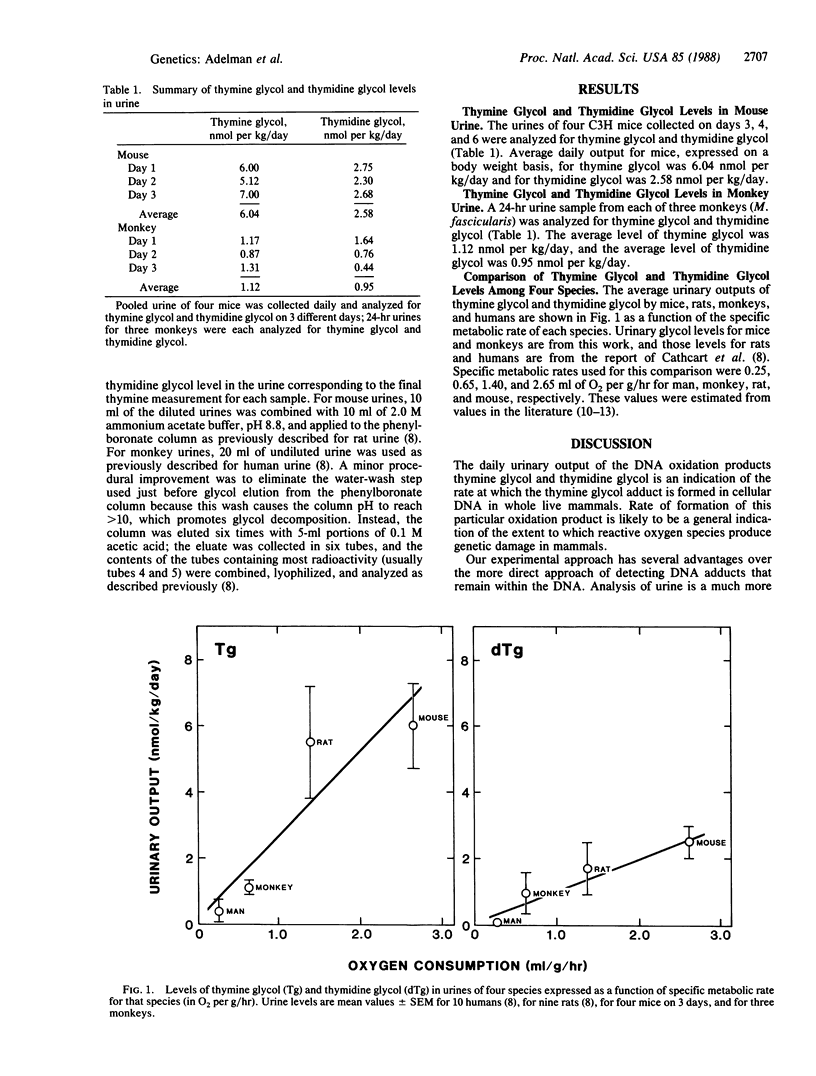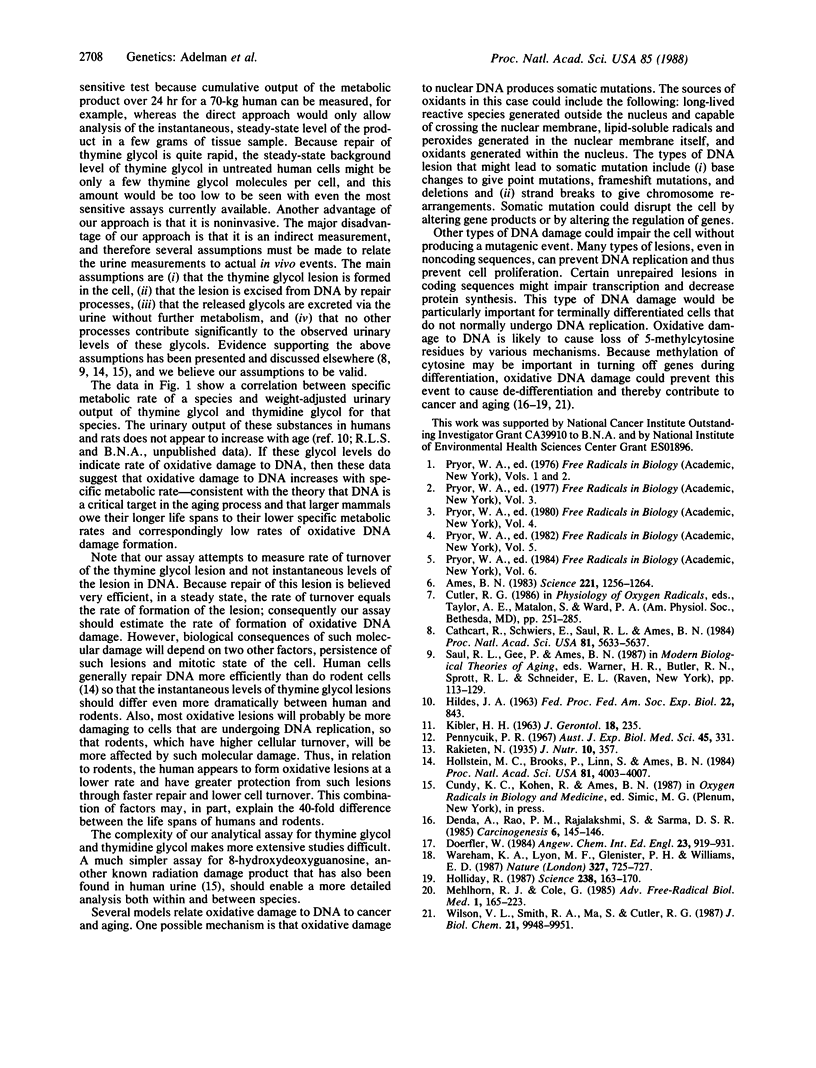Abstract
Oxidative damage to DNA is caused by reactive by-products of normal metabolism, as well as by radiation. Oxidized DNA bases excised by DNA repair enzymes and excreted in urine were measured in four different species to determine the relation between specific metabolic rate (ml of O2 consumed per gram of body weight per hr) and oxidative DNA damage. An average of 6.04 nmol of thymine glycol per kg/day and 2.58 nmol of thymidine glycol per kg/day were found in mouse urine and 1.12 nmol of thymine glycol per kg/day and 0.95 nmol of thymidine glycol per kg/day were found in monkey urine. On a body weight basis, mice excrete 18 times more thymine glycol plus thymidine glycol than do humans, and monkeys excrete 4 times more thymine glycol plus thymidine glycol than do humans. When results among mice, rats, monkeys, and humans are compared, specific metabolic rate correlates highly with oxidative DNA damage. These findings are consistent with the theory that free radical-induced DNA damage may play a central role in the aging process.
Full text
PDF


Selected References
These references are in PubMed. This may not be the complete list of references from this article.
- Ames B. N. Dietary carcinogens and anticarcinogens. Oxygen radicals and degenerative diseases. Science. 1983 Sep 23;221(4617):1256–1264. doi: 10.1126/science.6351251. [DOI] [PubMed] [Google Scholar]
- Cathcart R., Schwiers E., Saul R. L., Ames B. N. Thymine glycol and thymidine glycol in human and rat urine: a possible assay for oxidative DNA damage. Proc Natl Acad Sci U S A. 1984 Sep;81(18):5633–5637. doi: 10.1073/pnas.81.18.5633. [DOI] [PMC free article] [PubMed] [Google Scholar]
- Denda A., Rao P. M., Rajalakshmi S., Sarma D. S. 5-azacytidine potentiates initiation induced by carcinogens in rat liver. Carcinogenesis. 1985 Jan;6(1):145–146. doi: 10.1093/carcin/6.1.145. [DOI] [PubMed] [Google Scholar]
- HILDES J. A. Comparison of coastal Eskimos and Kalahari Bushmen. Fed Proc. 1963 May-Jun;22:843–845. [PubMed] [Google Scholar]
- Holliday R. The inheritance of epigenetic defects. Science. 1987 Oct 9;238(4824):163–170. doi: 10.1126/science.3310230. [DOI] [PubMed] [Google Scholar]
- Hollstein M. C., Brooks P., Linn S., Ames B. N. Hydroxymethyluracil DNA glycosylase in mammalian cells. Proc Natl Acad Sci U S A. 1984 Jul;81(13):4003–4007. doi: 10.1073/pnas.81.13.4003. [DOI] [PMC free article] [PubMed] [Google Scholar]
- KIBLER H. H., SILSBY H. D., JOHNSON H. D. METABOLIC TRENDS AND LIFE SPAN OF RATS LIVING AT 9 C. AND 28 C. J Gerontol. 1963 Jul;18:235–239. doi: 10.1093/geronj/18.3.235. [DOI] [PubMed] [Google Scholar]
- Pennycuik P. R. A comparison of the effects of a variety of factors on the metabolic rate of the mouse. Aust J Exp Biol Med Sci. 1967 Aug;45(4):331–346. doi: 10.1038/icb.1967.33. [DOI] [PubMed] [Google Scholar]
- Wareham K. A., Lyon M. F., Glenister P. H., Williams E. D. Age related reactivation of an X-linked gene. 1987 Jun 25-Jul 1Nature. 327(6124):725–727. doi: 10.1038/327725a0. [DOI] [PubMed] [Google Scholar]
- Wilson V. L., Smith R. A., Ma S., Cutler R. G. Genomic 5-methyldeoxycytidine decreases with age. J Biol Chem. 1987 Jul 25;262(21):9948–9951. [PubMed] [Google Scholar]


